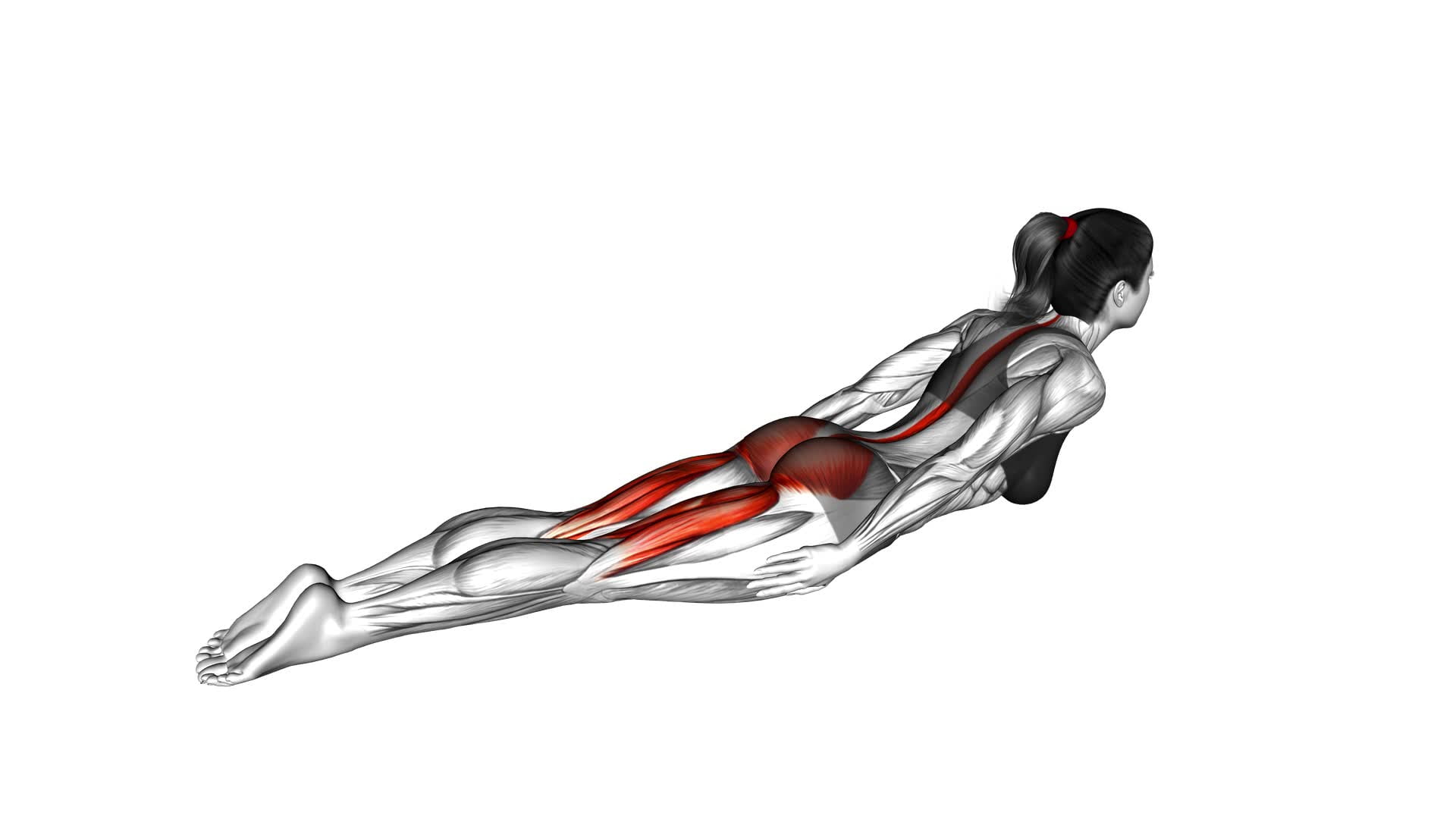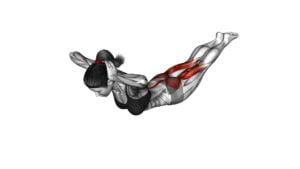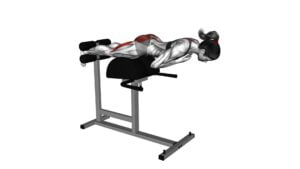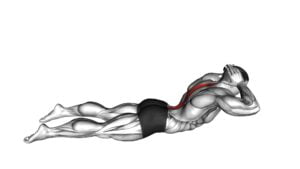Floor Hyperextension (VERSION 2) (female) – Video Exercise Guide & Tips

Are you looking to strengthen and tone your lower back and glutes? Then Floor Hyperextension (Version 2) is the exercise for you!
Watch This Exercise Video
This video exercise guide will show you the proper form and technique, as well as common mistakes to avoid.
With variations and progressions to challenge yourself, you'll be on your way to a stronger posterior chain.
Don't forget to follow the safety tips and precautions to prevent any injuries.
Let's get started!
Key Takeaways
- Floor hyperextension (Version 2) is a beneficial exercise for female fitness, as it targets core strength and strengthens the back, glutes, and hamstrings.
- This exercise also improves posture, stability, and spinal alignment, while increasing hip mobility and helping to prevent lower back pain.
- It is important to maintain proper form and technique, avoiding common mistakes such as overextending or arching the back excessively, using momentum, and locking the knees.
- Modifications and variations, such as using support under the hips or incorporating weights or a Swiss ball, can be made to cater to different fitness levels and prevent plateaus.
Benefits of Floor Hyperextension (VERSION 2) (female)
You can experience several benefits from performing Floor Hyperextension (VERSION 2) (female) exercises. These exercises specifically target female fitness and help improve core strength. By engaging in Floor Hyperextension (VERSION 2) (female) exercises, you can strengthen the muscles in your back, glutes, and hamstrings. This, in turn, helps to enhance your overall posture and stability.
One of the main benefits of Floor Hyperextension (VERSION 2) (female) exercises is the improvement in core strength. Your core muscles play a crucial role in maintaining balance and stability, and by performing these exercises, you can effectively strengthen these muscles. This can lead to better overall functional strength and can also help prevent injuries.
Another advantage of Floor Hyperextension (VERSION 2) (female) exercises is the development of strong glutes and hamstrings. These exercises specifically target these muscle groups, helping to tone and strengthen them. Strong glutes and hamstrings not only contribute to a more aesthetically pleasing physique but also enhance athletic performance and reduce the risk of lower back pain.
Proper Form and Technique for Floor Hyperextension (VERSION 2) (female)
To perform Floor Hyperextension (VERSION 2) (female) exercises with proper form and technique, focus on engaging your core muscles while simultaneously extending your back, glutes, and hamstrings. Here are some tips to help you achieve the correct form and get the most out of your workout:
- Start by lying face down on the floor with your legs extended and your arms by your sides.
- Place your hands behind your head or cross them over your chest to support your neck and upper back.
- Slowly lift your upper body off the floor, using the muscles in your lower back, glutes, and hamstrings.
- Keep your neck in a neutral position and avoid straining or arching your back too much.
If you're a beginner or looking for modifications, here are some options to consider:
- Place a rolled-up towel or small pillow under your hips for added support.
- Perform the exercise with a smaller range of motion, focusing on the contraction of your muscles rather than how high you can lift.
- If you have difficulty lifting your upper body off the floor, start with a modified version where you lift just your chest and shoulders.
By following these guidelines and making adjustments as needed, you can ensure that you're performing Floor Hyperextension (VERSION 2) (female) exercises correctly and safely.
Now, let's move on to the next section, where we'll discuss common mistakes to avoid during this exercise.
Common Mistakes to Avoid During Floor Hyperextension (Version 2) (Female)
One common mistake to avoid during Floor Hyperextension (Version 2) (Female) exercises is overextending your back, which can lead to strain or injury. It's important to maintain proper form and technique to maximize the effectiveness of the exercise while minimizing the risk of injury. Here are some common mistakes to avoid and some tips and tricks to help you perform the exercise correctly.
Firstly, avoid arching your back excessively during the movement. This can put excessive strain on your lower back and may lead to discomfort or injury. Instead, focus on engaging your core and maintaining a neutral spine throughout the exercise.
Another common mistake is using momentum to lift your torso off the ground. This takes away from the effectiveness of the exercise and puts unnecessary stress on your back. Instead, focus on using your lower back muscles to initiate the movement and lift your torso off the ground in a controlled manner.
Additionally, avoid locking your knees during the exercise. This can cause undue strain on your knee joints. Instead, keep a slight bend in your knees throughout the movement to maintain stability and protect your knees.
Lastly, be mindful of your breathing during the exercise. Avoid holding your breath or shallow breathing. Instead, take deep breaths in and out throughout the movement to oxygenate your muscles and maintain proper form.
Variations and Progressions of Floor Hyperextension (VERSION 2) (female)
As you progress in your Floor Hyperextension (Version 2) (Female) exercises, there are various variations and progressions you can incorporate to challenge your muscles and continue improving your strength and stability. Here are some variations and modifications you can try:
- Single-leg Floor Hyperextension: Instead of using both legs, perform the exercise with one leg at a time. This increases the demand on your glutes and hamstrings, providing a greater challenge to your muscles.
- Weighted Floor Hyperextension: To further intensify the exercise, you can hold a dumbbell or kettlebell against your chest while performing the movement. Adding weight increases resistance, making your muscles work harder.
- Swiss Ball Floor Hyperextension: Place a Swiss ball under your hips and perform the hyperextension exercise. This variation adds an element of instability, requiring your core muscles to work harder to maintain balance and control.
- Barbell Floor Hyperextension: Instead of using your body weight, you can use a barbell across your shoulders to add resistance. This variation allows for greater loading of the muscles and can help promote further strength gains.
Incorporating these variations and modifications into your Floor Hyperextension (Version 2) (Female) routine can help prevent plateaus and keep your workouts challenging and effective. Remember to always maintain proper form and listen to your body to avoid any injuries.
Safety Tips and Precautions for Floor Hyperextension (VERSION 2) (female)
When performing the Floor Hyperextension (Version 2) (female), it's important to prioritize safety and take necessary precautions. To ensure a safe and effective workout, there are a few key considerations to keep in mind.
Firstly, it's essential to have the proper equipment. For the Floor Hyperextension (Version 2) (female) exercise, you'll need a mat or padded surface to lie on. This will provide support and cushioning for your body during the movement. Additionally, having a stable surface is crucial to maintain balance and prevent any potential injuries.
In terms of recommended workout frequency, it's advised to incorporate the Floor Hyperextension (Version 2) (female) exercise into your routine 2-3 times per week. However, it's important to listen to your body and gradually increase the frequency and intensity over time. Always start with a warm-up and gradually progress to higher repetitions and sets as your strength and flexibility improve.
Remember to maintain proper form throughout the exercise. Keep your core engaged, shoulders relaxed, and back aligned. Avoid any jerky or sudden movements that may strain your lower back or other muscle groups.
Frequently Asked Questions
How Many Calories Can You Burn by Doing Floor Hyperextension (Version 2) (Female)?
By performing floor hyperextension (version 2) (female), you can burn a significant amount of calories. This exercise not only aids in overall fitness, but also helps strengthen your lower back, glutes, and hamstrings.
When it comes to calorie burn, floor hyperextension (version 2) (female) can be compared to other exercises like running or cycling. However, the exact number of calories burned will depend on factors such as intensity, duration, and individual body composition.
Can Floor Hyperextension (Version 2) (Female) Help in Reducing Lower Back Pain?
Floor hyperextension (version 2) (female) is an effective exercise for strengthening the core. It targets the muscles in your lower back and helps improve stability.
When it comes to reducing lower back pain, floor hyperextension (version 2) (female) can be beneficial, but it's important to note that the effectiveness may vary for individuals. It can be helpful to incorporate other exercises such as stretching and strengthening exercises to further alleviate lower back pain.
Consult with a healthcare professional for personalized advice.
What Are the Muscles Targeted During Floor Hyperextension (Version 2) (Female)?
During floor hyperextension (version 2) (female), several muscles are targeted.
The exercise primarily engages the erector spinae muscles, which run along the spine and help with back extension.
Additionally, the gluteus maximus and hamstrings are activated as they work to stabilize and extend the hips.
This exercise also activates the core muscles, including the rectus abdominis and obliques, which help with stability and maintaining a neutral spine.
How Often Should Floor Hyperextension (Version 2) (Female) Be Performed for Optimal Results?
For optimal results, you should perform floor hyperextension (version 2) (female) with an optimal frequency. The frequency will depend on your fitness level and goals.
It's recommended to start with 2-3 sessions per week and gradually increase as your strength and endurance improve.
It's also important to incorporate variations and progressions to challenge your muscles further. This will help you continually progress and achieve your desired results.
Can Floor Hyperextension (Version 2) (Female) Improve Posture?
Floor hyperextension (version 2) (female) is a great exercise to improve your posture. By regularly performing this exercise, you can enhance your core strength and flexibility. It targets the muscles in your back, glutes, and hamstrings, which are key in maintaining proper posture.
This exercise helps strengthen the muscles that support your spine, allowing you to stand tall and maintain a good posture throughout the day. Incorporating floor hyperextension (version 2) (female) into your routine can have significant benefits for your overall posture.
Conclusion
In conclusion, the Floor Hyperextension (Version 2) is a beneficial exercise for females looking to strengthen their lower back and glutes.
By maintaining proper form and avoiding common mistakes, individuals can maximize the effectiveness of this exercise.
Additionally, there are variations and progressions available to cater to different fitness levels.
It's important to prioritize safety and follow precautions to prevent any injuries during the Floor Hyperextension (Version 2).

Author
Years ago, the spark of my life’s passion ignited in my mind the moment I stepped into the local gym for the first time. The inaugural bead of perspiration, the initial endeavor, the very first surge of endorphins, and a sense of pride that washed over me post-workout marked the beginning of my deep-seated interest in strength sports, fitness, and sports nutrition. This very curiosity blossomed rapidly into a profound fascination, propelling me to earn a Master’s degree in Physical Education from the Academy of Physical Education in Krakow, followed by a Sports Manager diploma from the Jagiellonian University. My journey of growth led me to gain more specialized qualifications, such as being a certified personal trainer with a focus on sports dietetics, a lifeguard, and an instructor for wellness and corrective gymnastics. Theoretical knowledge paired seamlessly with practical experience, reinforcing my belief that the transformation of individuals under my guidance was also a reflection of my personal growth. This belief holds true even today. Each day, I strive to push the boundaries and explore new realms. These realms gently elevate me to greater heights. The unique combination of passion for my field and the continuous quest for growth fuels my drive to break new ground.







